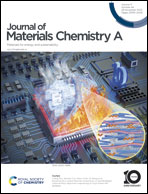Removal of total chromium in wastewater via simultaneous photocatalysis and adsorption using calcium silicate hydrate-based composites†
Abstract
Converting Cr(VI) to Cr(III) and subsequent precipitation of Cr(III) represents an efficient approach for wastewater treatment. Although it is possible to eliminate Cr(III) by adjusting the pH to elicit precipitation, this method is expensive and can lead to secondary pollution. Herein, we report a composite (C-S-U) composed of calcium silicate hydrate (C-S-H) and UiO-66-NH2 nanoparticles (UN NPs). We demonstrated a remarkable synergistic effect for the purification of total chromium concentration (Cr(T)) attributed to the affinity of Cr(III) to C-S-H, coupled with the Cr(III) sorption-enhanced photocatalysis. C-S-U exhibited a significantly enhanced photocatalytic rate (0.052 min−1) for Cr(VI) but also delivered outstanding sorption capacity (217.9 mg g−1) towards Cr(III). Cr(T) could be reduced to an ultra-low level (∼0.007 mg L−1) within 90 min. Meanwhile, regeneration of Cr(III)-passivated C-S-U and Cr recollection was achieved. Electrochemical analysis and X-ray photoelectron spectroscopy were undertaken to reveal the mechanism of removal.



 Please wait while we load your content...
Please wait while we load your content...